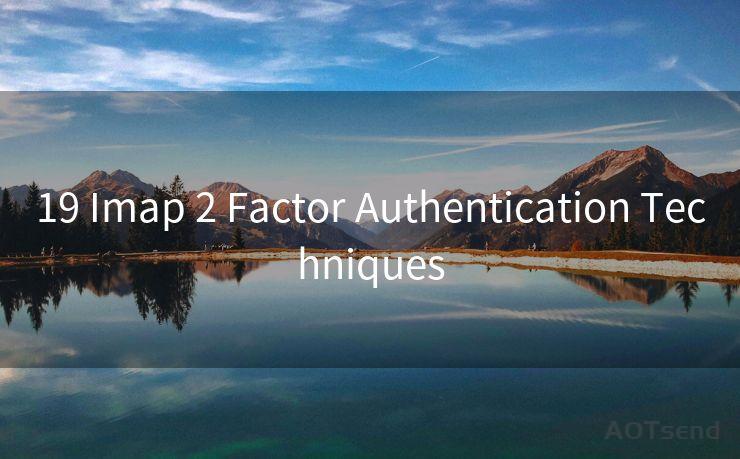19 Imap 2 Factor Authentication Techniques




In the digital age, protecting your online accounts and data has become paramount. Among the various security measures available, two-factor authentication (2FA) stands out as a robust method to enhance account security. When it comes to email accounts, especially those using the Internet Message Access Protocol (IMAP), implementing 2FA is crucial. Let's explore the top 19 IMAP and two-factor authentication techniques that can bolster your online security.
1. Understanding IMAP and Its Vulnerabilities
IMAP is a widely used protocol for accessing email messages stored on a remote server. However, like any other online service, IMAP accounts are vulnerable to attacks such as phishing, brute-force attacks, and account hijacking. This underscores the need for additional security measures, and 2FA is a proven solution.

2. Introduction to Two-Factor Authentication (2FA)
Two-factor authentication adds an extra layer of security to your online accounts. It requires two forms of identification: something you know (like a password) and something you have (like a smartphone or a hardware token).
3. IMAP Servers That Support 2FA
Not all IMAP servers natively support 2FA. It's essential to choose an IMAP provider that offers this feature. Providers like Gmail, Outlook, and some others have implemented 2FA to enhance account security.
4. Setting Up 2FA for Your IMAP Account
The process of setting up 2FA varies depending on your IMAP provider. Typically, it involves enabling the feature in your account settings and then following the prompts to set up your second factor, which is often a mobile app or a hardware token.
5. Using Authenticator Apps
Authenticator apps, such as Google Authenticator or Authy, generate one-time passwords (OTP) that are valid for a short period. These OTPs provide an additional verification step when logging into your IMAP account.
6. Hardware Tokens for 2FA
Hardware tokens, such as Yubico's YubiKey, offer an even stronger form of 2FA. These physical devices generate unique codes that cannot be replicated, providing an extra level of security compared to authenticator apps.
7. Biometrics as a Second Factor
Some IMAP providers allow you to use biometrics, such as fingerprints or facial recognition, as a second factor for authentication. This method is convenient and secure, as it relies on unique biological characteristics.
8. SMS-Based 2FA
Although not as secure as other methods, SMS-based 2FA can still provide an additional layer of protection. It involves receiving a verification code via text message to your registered phone number.
9. Email-Based 2FA
Similar to SMS-based 2FA, email-based 2FA sends a verification link or code to your alternate email address. This method is less secure than others but can be used as a backup option.
10. Push Notifications for 2FA
Some IMAP providers offer push notifications as a second factor. This method sends a notification to your registered device, asking you to approve or deny the login attempt.
11. Backup Methods for 2FA
It's crucial to have backup methods for 2FA, especially if you lose access to your primary second factor. Consider setting up multiple authentication methods and keeping recovery codes securely stored.
12. Security Challenges with 2FA
While 2FA significantly enhances security, it's not without challenges. Users must be vigilant against phishing attacks that try to bypass 2FA and ensure their devices and authenticator apps are secure.
13. Educating Users on 2FA
Adopting 2FA is only effective if users understand its importance and how to use it properly. IMAP providers should offer clear instructions and educational resources to help users set up and manage their 2FA methods.
14. Balancing Security and Usability
Implementing 2FA can sometimes affect usability, especially if the process is too complex. IMAP providers should strike a balance between security and user-friendliness to encourage widespread adoption.
🔔🔔🔔
【AOTsend Email API】:AOTsend is a Managed Email Service for sending transactional emails. Support Email Types: reminders, authentication, confirmations, notifications, verification codes, invoices, password resets, account activations, billing statements, two-factor authentication (2FA), and one-time passwords (OTP) emails, etc. $0.28 per 1000 Emails. 99% Delivery, 98% Inbox Rate.
You might be interested in:
Why did we start the AOTsend project, Brand Story?
What is a Managed Email API, How it Works?
Best 25+ Email Marketing Platforms (Authority,Keywords&Traffic Comparison)
Best 24+ Email Marketing Service (Price, Pros&Cons Comparison)
Email APIs vs SMTP: How they Works, Any Difference?
15. The Future of 2FA and IMAP
As technology evolves, we can expect more innovative and secure 2FA methods for IMAP accounts. From biometric authentication to advanced hardware tokens, the future of 2FA promises even stronger protection.
16. IMAP and 2FA in the Enterprise Environment
For businesses using IMAP for corporate email, implementing 2FA is crucial. Enterprises should consider additional security measures, such as single sign-on (SSO) solutions and multi-factor authentication for sensitive accounts.




Scan the QR code to access on your mobile device.
Copyright notice: This article is published by AotSend. Reproduction requires attribution.
Article Link:https://www.mailwot.com/p3201.html



